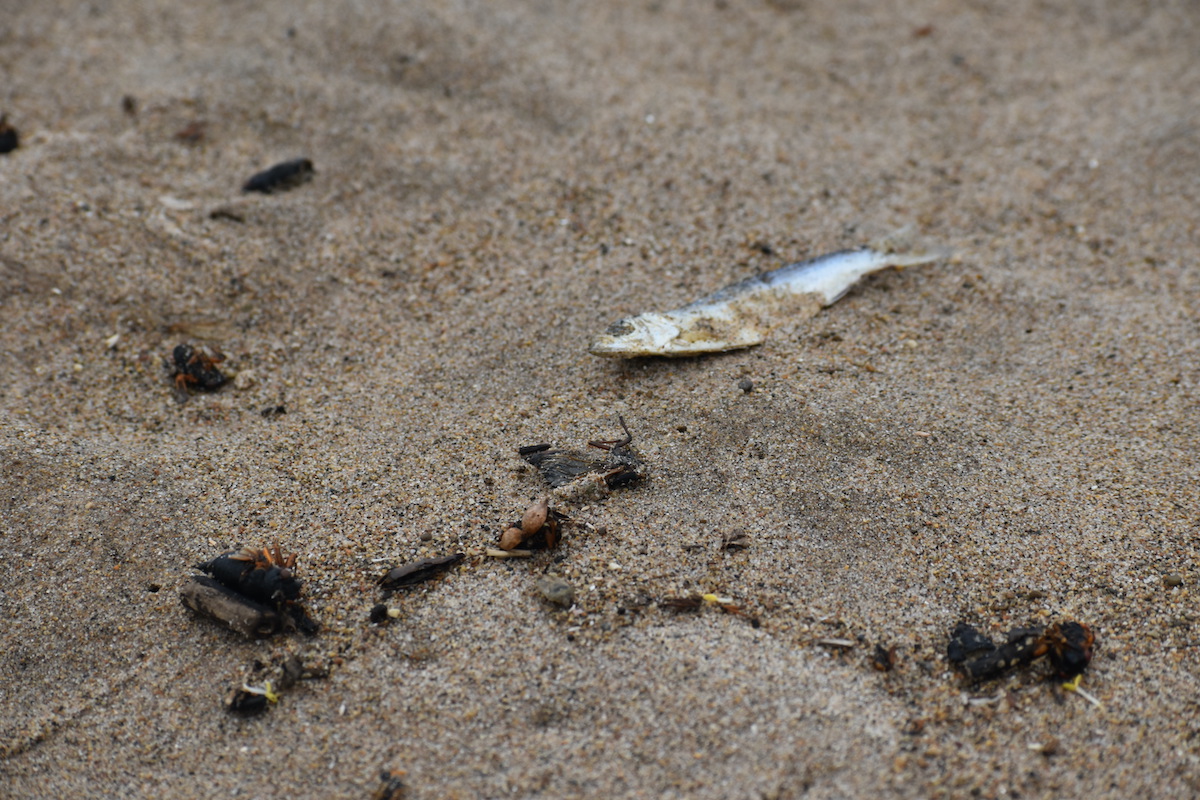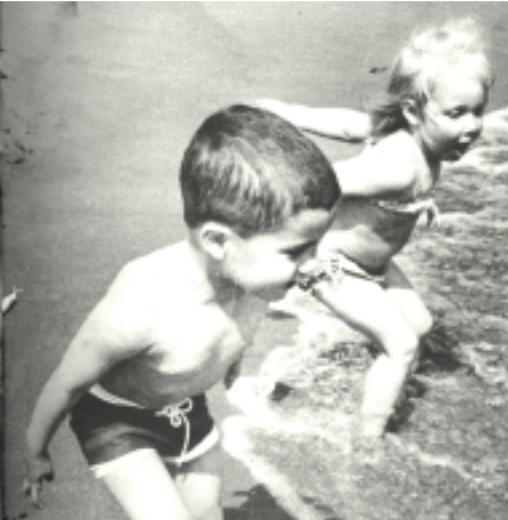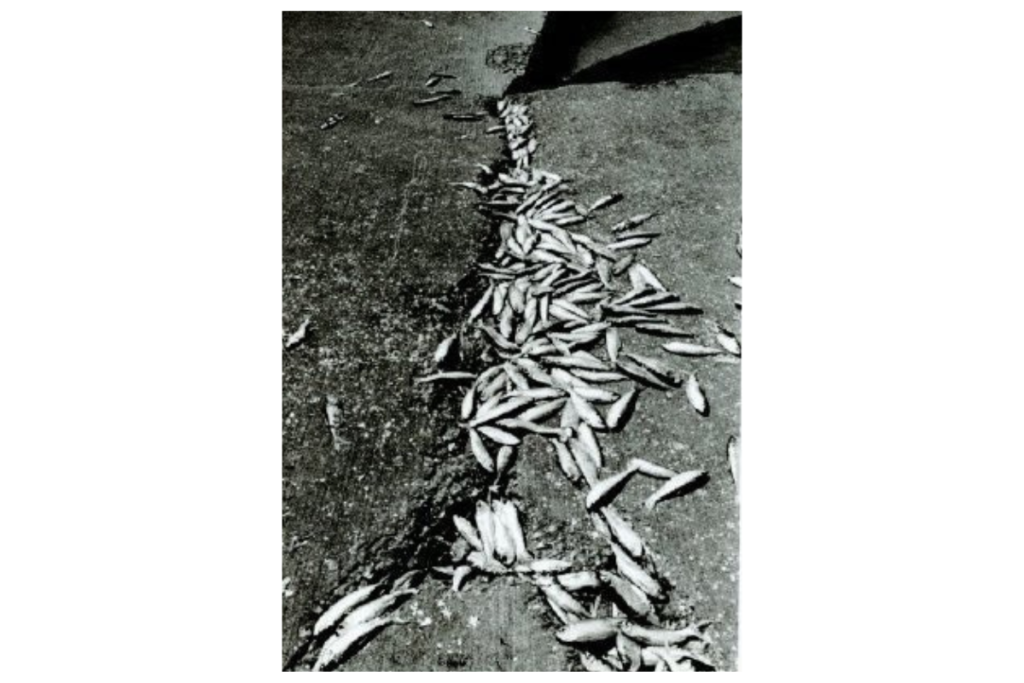
Fishing for answers? Those dead little fish on the shoreline aren’t fun to look at, but it’s nothing compared to 1967
Twas’ the great alewife invasion of 2024 — well, not really.
This June, many North Shore beaches saw an influx of dead silvery fish, known as alewives, lining the shoreline along with a smattering of dead cicadas. Every year, as the temperature shifts from spring to summer, the alewives endure a mass die-off, leaving them floating up onto our shoreline.
According to the Illinois Department of Natural Resources, alewives are small silver herrings that are not native to Lake Michigan. They feed on plankton and make their way to shallow waters around June to spawn.
Park officials in Winnetka and Glencoe — and any beachgoers who have walked the shorelines — have noted an increase in beached alewives this year
With the alewife being an adopted part of the lake’s ecosystem, this year’s die-off is a good sign. According to Santucci, the alewives seemed to have a boom in population in 2023, which could be seen in IDNR data and reports of large salmon caught in Lake Michigan, signifying an abundance of alewife to snack on.
While the sight of dead alewife and cicadas is offputting to the average beachgoer, many lifelong residents know the worst of these alewife die-offs.
In 1967, rather than the beautiful sand-lined coast we know and love, nearly all of Chicago and the North Shore’s beaches were coated in dead alewives.
A featured story from the Wilmette Historical Society recounts the disgusting and smelly sight.
“By July, the Wilmette Park District was hauling six or seven truck loads of alewives out to a landfill in Des Plaines every single day,” the story reads. “Next door at Winnetka’s beach, the dead fish were piled up one foot deep and ten feet wide, while Highland Park hauled sixty tons of dead fish away in two days.”
Vic Santucci, the Lake Michigan Program Director at the IDNR, knows the alewife well beyond the scope of his work. Santucci shared that he grew up in Oak Park when the infestation occurred. He will never forget the foul stench during the summer of 1967.
“They would have to use front-end loaders to load them up in a dump truck and take them away,” he said. “You could smell them from a mile away. We would take the L into the city, and as soon as you got off the L, maybe two or three blocks from the lake, you’d be like, ‘Oh my god.’”

Scientists still are unsure of what left our beaches knee-deep in dead alewives. Santucci said that with the nonnative species being uncontrolled until the late 1960s, it is likely that the population grew rapidly without predators in Lake Michigan.
Two species of salmon were introduced into Lake Michigan in the late 1960s to help manage the alewife population and create more competitive fishing. Since then, the salmon and alewives have become important parts of the lake’s ecosystem despite being nonnative.
Yet, it is still unclear what causes the annual alewife mass die-off. Santucci drew from a multitude of possibilities, with one of the main factors being stress. Scientists are unsure whether the stress is related to spawning, changing temperatures or a lack of food.
One possible impact could be wind. According to Santucci, a strong northern or western wind can push the warm surface water out to Michigan and pull the lower, colder water to our shoreline. For the alewife, this can result in temperature shock.
Warmer waters can also create stress as it draws more energy from the alewives. Santucci said that the warmer waters can drain alewives’ energy reserves, making it harder for them to feed on plankton.
Another answer could be laying at the bottom of the lake. Santucci cites efforts to reduce nutrients in the water and the introduction of mussels into Lake Michigan as possible culprits.
“There’s not as much biological activity because there’s not as much nutrients,” Santucci said. “The nutrients are pulled down to the bottom where the mussels are, so that doesn’t leave as much food out there for plankton-eating fish like the alewife.”

This population boom is likely the explanation for the increased number of dead alewives arriving on Lake Michigan’s shoreline. Luckily, there was no need to call in the dump trucks. Most of the local beaches let nature take its course.
Alewives made their way ashore at Winnetka’s beaches, joined by large numbers of cicadas also washing up. Matt Barton, Winnetka lakefront manager, said that the alewives make an annual appearance, but there were more than usual this year.
Luckily, there was no need to haul them out like in 1967. Apart from cleaning the boat launch and piers, Barton noted that the seagulls seemed to do much of the cleaning for them.
Winnetka beachgoers seemed unbothered by the new guests. Barton said that many residents were just curious about the fish and their arrival.
“Luckily, the seagulls got to them before we got any complaints,” Barton said.
Over at Glencoe’s beaches, it’s a similar story. Erika Doroghazi is the administrative support and special projects manager at the Glencoe Park District and chair of the Green Team. Doroghazi said Glencoe beach staff also noticed a larger amount of alewives this season.
According to Doroghazi, the staff essentially incorporated the alewives and cicadas into their normal litter and debris clean-up. Performing a quick sweep of the beach made the mess easy to clean up, and Doroghazi said they received no complaints from visitors.
The Record is a nonprofit, nonpartisan community newsroom that relies on reader support to fuel its independent local journalism.
Subscribe to The Record to fund responsible news coverage for your community.
Already a subscriber? You can make a tax-deductible donation at any time.

Cleo Pool
Cleo Saliano Pool is the 2024 Record Intern and an incoming senior at American University, studying journalism and graphic design. She recently worked for the Investigative Reporting Workshop, where she developed her passion for nonprofit news. Born and raised in Wilmette, Cleo loves reporting local news and connecting with her community.


